The University of Chicago Press, Chicago 60637
The University of Chicago Press, Ltd., London
Copyright 1962, 1982, 2002 by The University of Chicago
All rights reserved. Originally published 1962
Reissued with a new Preface in 1982, and again in 2002.
Printed in the United States of America
18 17 16 15 14 13 12 11 10 8 9 10 12 13
ISBN-13: 978-0-226-26420-2 (cloth)
ISBN-13: 978-0-226-26421-9 (paper)
ISBN-10: 0-226-26420-3 (cloth)
ISBN-10: 0-226-26421-1 (paper)
ISBN-13: 978-0-226-26420-2 (e-book)
Library of Congress Cataloging-in-Publication Data
Friedman, Milton, 1912
Capitalism and freedom / Milton Friedman; with the assistance of Rose D. Friedman.; with a new preface by the author40th anniversary ed.
p. cm.
Includes bibliographical references and index.
ISBN 0-226-26420-3 (cloth: alk. paper)ISBN 0-226-26421-1 (paper: alk. paper)
1. Capitalism. 2. State, The. 3. Liberty. 4. United StatesEconomic policy. I. Friedman, Rose D. II. Title.
HB501 .F7 2002
330.122dc21
2002067530
 The paper used in this publication meets the minimum requirements of the American National Standard for Information SciencesPermanence of Paper for Printed Library Materials, ANSI 239.48-1992.
The paper used in this publication meets the minimum requirements of the American National Standard for Information SciencesPermanence of Paper for Printed Library Materials, ANSI 239.48-1992.
CAPITALISM AND FREEDOM
40th Anniversary Edition
With a new Preface by the Author
MILTON FRIEDMAN
WITH THE ASSISTANCE OF ROSE D. FRIEDMAN
The University of Chicago Press
Chicago and London
Milton Friedman is a senior research fellow at the Hoover Institution, Stanford University, and the Paul Snowden Russell Distinguished Service Professor Emeritus of Economics at the University of Chicago. In 1976 he was awarded the Nobel Memorial Prize in Economics. With his wife, Rose D. Friedman, he wrote the best-selling book, Free to Choose (1980) and a joint memoir (1998).
To
Janet and David
and their contemporaries
who must carry the torch of liberty
on its next lap

Contents

Preface, 2002
I N MY PREFACE TO THE 1982 edition of this book, I documented a dramatic shift in the climate of opinion, manifested in the difference between the way this book was treated when it was first published in 1962, and the way my wifes and my subsequent book, Free to Choose, presenting the same philosophy, was treated when it was published in 1980. That change in the climate of opinion developed while and partly because the role of government was exploding under the influence of initial welfare state and Keynesian views. In 1956, when I gave the lectures that my wife helped shape into this book, government spending in the United Statesfederal, state, and localwas equal to 26 percent of national income. Most of this spending was on defense. Non-defense spending was 12 percent of national income. Twenty-five years later, when the 1982 edition of this book was published, total spending had risen to 39 percent of national income and non-defense spending had more than doubled, amounting to 31 percent of national income.
That change in the climate of opinion had its effect. It paved the way for the election of Margaret Thatcher in Britain and Ronald Reagan in the United States. They were able to curb Leviathan, though not to cut it down. Total government spending in the United States did decline slightly, from 39 percent of national income in 1982 to 36 percent in 2000, but that was almost all due to a reduction in spending for defense. Non-defense spending fluctuated around a roughly constant level: 31 percent in 1982, 30 percent in 2000.
The climate of opinion received a further boost in the same direction when the Berlin wall fell in 1989 and the Soviet Union collapsed in 1992. That brought to a dramatic end an experiment of some seventy years between two alternative ways of organizing an economy: top-down versus bottom-up; central planning and control versus private markets; more colloquially, socialism versus capitalism. The result of that experiment had been foreshadowed by a number of similar experiments on a smaller scale: Hong Kong and Taiwan versus mainland China; West Germany versus East Germany; South Korea versus North Korea. But it took the drama of the Berlin Wall and the collapse of the Soviet Union to make it part of conventional wisdom, so that it is now taken for granted that central planning is indeed The Road to Serfdom, as Friedrich A. Hayek titled his brilliant 1944 polemic.
What is true for the United States and Great Britain is equally true for the other Western advanced countries. In country after country, the initial postwar decades witnessed exploding socialism, followed by creeping or stagnant socialism. And in all these countries the pressure today is toward giving markets a greater role and government a smaller one. I interpret the situation as reflecting the long lag between opinion and practice. The rapid socialization of the postWorld War II decades reflected the prewar shift of opinion toward collectivism; the creeping or stagnant socialism of the past few decades reflects the early effects of the postwar change of opinion; future desocialization will reflect the mature effects of the change in opinion reinforced by the collapse of the Soviet Union.
The change in opinion has had an even more dramatic effect on the formerly underdeveloped world. That has been true even in China, the largest remaining explicitly communist state. The introduction of market reforms by Deng Xiaoping in the late seventies, in effect privatizing agriculture, dramatically increased output and led to the introduction of additional market elements into a communist command society. The limited increase in economic freedom has changed the face of China, strikingly confirming our faith in the power of free markets. China is still very far from being a free society, but there is no doubt that the residents of China are freer and more prosperous than they were under Maofreer in every dimension except the political. And there are even the first small signs of some increase in political freedom, manifested in the election of some officials in a growing number of villages. China has far to go, but it has been moving in the right direction.
In the immediate postWorld War II period, the standard doctrine was that development of the third world required central planning plus massive foreign aid. The failure of that formula wherever it was tried, as was pointed out so effectively by Peter Bauer and others, and the dramatic success of the market-oriented policies of the East Asia tigersHong Kong, Singapore, Taiwan, South Koreahas produced a very different doctrine for development. By now, many countries in Latin America and Asia, and even a few in Africa have adopted a market-oriented approach and a smaller role for government. Many of the former Soviet satellites have done the same. In all those cases, in accordance with the theme of this book, increases in economic freedom have gone hand in hand with increases in political and civil freedom and have led to increased prosperity; competitive capitalism and freedom have been inseparable.
A final personal note: It is a rare privilege for an author to be able to evaluate his own work forty years after it first appeared. I appreciate very much having the chance to do so. I am enormously gratified by how well the book has withstood time and how pertinent it remains to todays problems. If there is one major change I would make, it would be to replace the dichotomy of economic freedom and political freedom with the trichotomy of economic freedom, civil freedom, and political freedom. After I finished the book, Hong Kong, before it was returned to China, persuaded me that while economic freedom is a necessary condition for civil and political freedom, political freedom, desirable though it may be, is not a necessary condition for economic and civil freedom. Along these lines, the one major defect in the book seems to me an inadequate treatment of the role of political freedom, which under some circumstances promotes economic and civic freedom, and under others, inhibits economic and civic freedom.
Next page
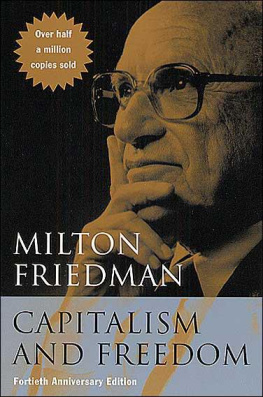
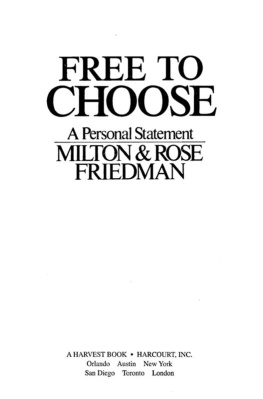
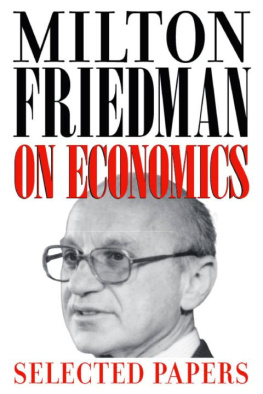
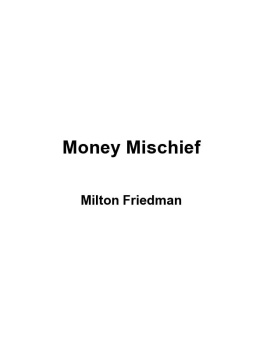
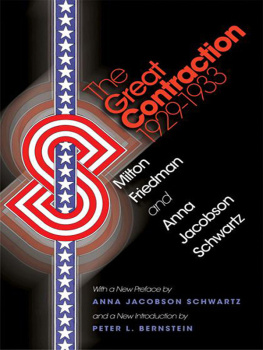



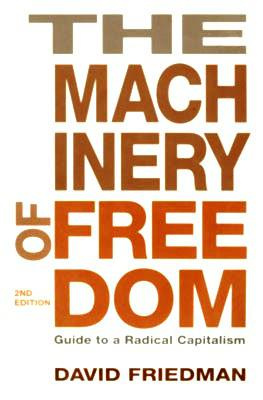
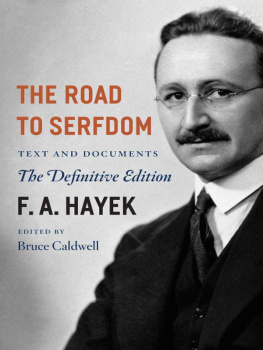

 The paper used in this publication meets the minimum requirements of the American National Standard for Information SciencesPermanence of Paper for Printed Library Materials, ANSI 239.48-1992.
The paper used in this publication meets the minimum requirements of the American National Standard for Information SciencesPermanence of Paper for Printed Library Materials, ANSI 239.48-1992.